Shipping containers are the backbone of global trade, transporting everyday goods and raw materials across oceans in large metal boxes. However, not all containers reach their intended destinations. The Associated Press has investigated the fate of thousands of shipping containers lost at sea, driven by various factors, including the increased size of vessels and the inherent risks of maritime logistics. Over time, ships have grown significantly in size, making them akin to high-rise buildings on water. This evolution has led to vessels capable of carrying enormous amounts of freight—up to ten times what was possible fifty years ago, but also significantly raising the stakes of container loss during transit.
The primary reasons for shipping container spills include severe weather conditions and maritime accidents. Modern ships, while large and capable of carrying vast amounts of cargo, are harder to maneuver and can be more susceptible to rolling in high waves. When containers are stacked high, a single mishap can lead to cascading failures, resulting in multiple containers plunging into the sea. Cargo mismanagement also plays a critical role; improperly labeled, weighed, or stowed cargo can destabilize container stacks. Ship operators rely heavily on shippers’ information, making it challenging to verify all container contents, which can lead to dangerous situations.
Statistics on shipping container losses are challenging to ascertain definitively. The World Shipping Council reports that around 1,480 containers are lost annually, yet this figure primarily reflects members’ reported data. Noteworthy incidents, like the recent loss of 1,300 containers near Taiwan, may go uncounted if they involve non-member companies. Despite being underreported, it is estimated that over the past 15 years, at least 20,000 containers have ended up at the bottom of oceans worldwide. The lack of consistent tracking emphasizes a significant issue for maritime safety and accountability.
The environmental implications of lost containers can be severe. Marine biologist Andrew DeVogelaere points out that containers can act as time capsules on the ocean floor, affecting marine ecosystems for centuries. Events such as the ONE Apus incident in 2020 show how a single mishap can scatter debris across vast distances, damaging marine life and habitats. Similarly, the sinking of the X-Press Pearl has had a devastating impact on the Sri Lankan coast, releasing hazardous materials and leading to widespread marine casualties. Cleanup operations have proven inadequate, highlighting the long-term effects of such disasters on local economies dependent on fishing.
Underreporting of shipping container losses compounds the challenge of addressing this issue. Marine insurers are likely privy to data that is not disclosed to the public, leading to gaps in the understanding of container loss across the industry. Additionally, while the recent amendments to global ocean treaties by the United Nations’ International Maritime Organization aim to improve transparency and require reporting of loss incidents, a lack of enforceable penalties leaves compliance uncertain. Addressing the chronic issues surrounding cargo mismanagement and container losses will require concerted efforts from shipping companies and regulatory bodies alike.
In summary, the investigation into lost shipping containers exposes significant challenges within the maritime shipping industry. While the scale of container transport has grown exponentially, so too have the accompanying risks. As globalization continues to shape trade practices, it is crucial to implement robust solutions and regulations that not only mitigate risks associated with container loss but also protect marine environments and coastal communities most affected by these accidents. The road ahead necessitates enhanced oversight and stronger partnerships between shipping organizations, regulatory bodies, and environmental agencies to ensure sustainability and accountability in maritime operations.










